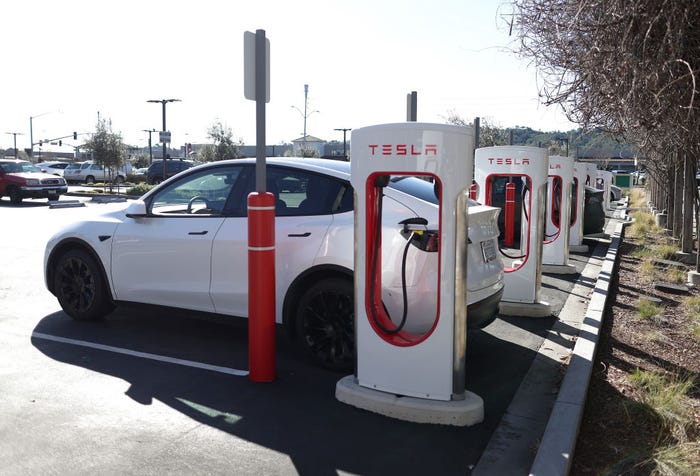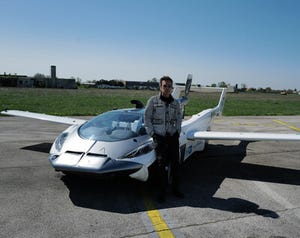IoT Predictions for 2019: Less Hype, More Pragmatism
What’s in store for the Internet of Things market next year? We’re setting out to answer that question between now and the end of the year with an expanding set of IoT predictions.
December 12, 2018

It seems at the close of every year, a handful of tech pundits project that the coming year will be the “year of IoT.” After several years in a row of warm rather than meteoric growth, there are fewer people making that claim for 2019. While it may seem like a clichéd projection, next year is likely to be something of a mixed bag for the Internet of Things. On the one hand, vendors are striving to make IoT easier to deploy, which could accelerate adoption. On the other hand, parallel technologies that could benefit IoT, including 5G and blockchain, will likely mostly remain immature throughout the coming year. To learn more about our IoT predictions for 2019, read on:
A Simplified Market Will Spur IoT Growth
The IoT market is poised to continue expanding and the market is gradually becoming easier to navigate. While in 2018, there is no shortage of IoT-based services to help organizations launch IoT projects, for many end users, deploying an IoT project at scale and managing it over time remains difficult. Forrester expects things to improve next year with an uptick in services to help end users “manage, monitor and operate the fragmented array of IoT devices, networks and assets.” Forrester expects companies with IoT deployments in the domains of manufacturing, health care, retail and utilities to sign nine-figure contracts with vendors to help them “run” their IoT projects.
The antenna vendor Taoglas has similar IoT predictions. “Vendors will begin to see their perseverance in IoT pay off,” said Dermot O’Shea, joint chief executive officer of Taoglas Group. “Vendors that have been around since the early days of IoT are finally beginning to make hay.”
[IoT World is the event that takes IIoT from inspiration to implementation, supercharging business and operations. Get your ticket now.]
While IoT pundits differ on whether the IoT market in 2019 will see steady or rapid growth, O’Shea is in the optimistic camp. “2019 is when we’ll see the real growth in the market that has been forecasted for years,” he said. “The reason? Many industries are beginning to finally see scale in their IoT applications, and new applications are popping up with scale that no one forecasted.” As evidence, he points to a surge in demand in IoT antennas. “While 10,000 units of an IoT antenna used to be a big order, 100,000-unit orders are now common,” he said.
While in the early years of IoT adoption, it was difficult to find connected projects achieving widespread adoption, but that is no longer the case. Smart speakers are on their way to becoming a commodity item for many consumers and IoT-enabled electric scooters are seeing rapid growth. There will soon be millions of them across the world, O’Shea said. “Street lighting, electricity meters, and other utility and smart city applications will also see exponential growth in 2019,” he added. “The IoT tsunami that was predicted for the latter half of the 2010s never materialized, but instead, a series of small waves will increase IoT deployment numbers dramatically.”
The Smart Home Market Will See Growth and Diversification
After a fuzzy period of smart home uncertainty in which consumers asked questions like: “Why would I want to have a connected toaster,” consumers — and vendors — are beginning to understand what an appealing smart home technology looks like.
Smart speakers, in particular, are strong, representing the bestselling consumer technology. Amazon has convinced 60 percent of its Prime members to buy at least one Amazon Echo and 30 percent of its non-Prime customer base has one, according to survey data from Business Insider. And while sales of Amazon Echo smart speakers appear to be approaching saturation, sales of the Google Home speaker and voice assistant are… picking up, surging ahead of the competition in 2018.
All indications show the smart home market will continue to grow, said Charlene Marini, vice president of strategy, IoT Services Group at Arm. Marini expects “an uptick in the availability of IoT home products with the expansion of products available to consumers from mainstream household brands.” Potential areas of growth include lighting, irrigation, heating and cooling, Marini said, adding that the technology will bring increased automation to everyday tasks.
A Northstar survey commissioned by Arm of 2000 consumers indicates that holiday spending on smart technology will be strong at the close of 2018, with 54 percent expecting to spend more on tech-based gifts than they did last year.
If holiday spending on smart home technology does indeed surge, it will likely be a boon for the market throughout 2019.
5G Won’t Hit Its Stride in 2019
No doubt about it, 5G hype is on the upswing. And the technology, when it roles out widely will undoubtedly be a boon for many IoT deployments. But already this December, there are already signs that early 5G implementations don’t live up to their marketing. A recent demo of the technology at the Qualcomm Snapdragon Technology Summit in Hawaii was reportedly less than impressive, according to The Verge. The 5G connections demoed at the event “aren’t anywhere near as fast as 5G is supposed to be,” writes Verge Senior News Editor Sean Hollister. “They’re slower than the Comcast internet connection I have at home.”
5G won’t likely hit its stride in 2019, according to Taoglas CEO Dermot O’Shea. “Many of the 5G announcements that are getting buzz are just marketing talk,” he said. Early 5G deployments are pre-standard and the field is simply too immature too clearly predict when the technology will reach mainstream deployment. While Samsung is prepping a 5G phone in collaboration with Verizon and AT&T, Apple will likely wait until 2020 to do the same.
Gartner estimated in 2018 that 5G adoption will hit mainstream adoption within two to five years. In 2019, 5G hardware will continue being installed at base station sites but the software “is simply not ready,” O’Shea said. 5G-enabled phones “will likely be ready by mid-2019, but that doesn’t mean anything until the rest of the pieces are in place. IoT does not need to worry about 5G until at least 2020,” he added.
More Focused (and Centralized) IoT-Related Blockchain Applications Will Arrive
In terms of leading technology trends in 2018, there was something of a blockchain bonanza in the beginning of the year that steadily cooled throughout the year. In August, Gartner estimated in a report that the technology was sinking into the trough of disillusionment, and that it was five to 10 years away from mainstream adoption.
While a vocal contingent of blockchain supporters remains committed to the original anti-authoritarian promise of the technology, blockchain is starting to look a lot like a business tool for the enterprise. Blockchain has powerful support from prominent financial firms like JP Morgan Chase and Berkshire Hathaway. It also enjoys backing from tech firms like SAP, Microsoft, Alphabet and Apple, as well as other notable firms such as Shell, Toyota and Walmart. In addition, companies such as Bosch, Fujitsu and Volkswagen are working with the distributed-ledger-focused IOTA Foundation to explore commercial blockchain applications. The support of such firms bodes well for the technology’s long-term commercial potential.
But as The New York Times recently captured in an article titled “The Hope and Betrayal of Blockchain,” the reputation of the technology as a decentralized trust-enabler is fading. As blockchain adoption gradually matures, the technology is becoming more centralized. There is, on the one hand, the growth in B2B distributed ledger applications based on centralized private blockchains. On the other hand, public peer-to-peer applications are “based on public blockchain networks — which are all centralized,” as the New York Times notes.
With a Recession Possibly on the Horizon, Discipline Will Come to Digital Transformation
Digital transformation has a dirty secret. Many digital transformation efforts fail to live up to their promise to transform customer experience and drive business and operational benefits. According to Forrester, more than half of all digital transformation efforts stalled in 2018. Similarly, IDC noted last year that 59 percent of organizations are at a “digital impasse.”
That’s not saying a business-as-usual approach… represents less of a risk for enterprise companies. But the role of the “digital transformation” banner in 2019 is anything but certain. In the past few years, the buzzword was predominately referred to high-risk, high-reward-type projects that create wholly new markets. Frequent examples include Amazon’s reinvention of itself as a cloud leader, Apple’s pioneering work in digital music, Uber’s reinvention of the taxi experience and Airbnb’s idea of private property into hotels.
But with recession fears looming, digital transformation is likely to grow more disciplined on operational efficiency and less on outright transformation in 2019. A group of 10 economists including the U.S. Federal Reserve project the U.S. economy to grow at a sluggish rate of 2.4 percent next year. With several economists such as Joseph LaVorgna, chief economist for the Americas at Natixis projecting a recession in 2020, it is likely that many enterprise companies will rein in plans for ambitious digital transformation efforts and shift their focus on projects with a short-term ROI.
The situation will likely be different in the beleaguered brick-and-mortar retail sector, which is being compelled to invest in digital technology to compete with online merchants. IDC expects \half of all retailers will deploy a digital core platform by the end of 2019. As we describe in the next item, retail giants including Amazon and Walmart are beginning to ambitiously deploy digital technology in physical store to help transform the customer experience.
Cashierless Stores Will Begin to Mushroom
We may be in an early phase of a shift toward widespread use of automation in retail environments, but the transition is picking up steam. Already, Amazon has opened up a handful of its cashierless Amazon Go stores — in Seattle, Chicago and San Francisco. It is planning on opening another in London. While the costs of outfitting a retail environment with the necessary sensors to do away with sensors may be substantial, there is a clear potential benefit in terms of time savings for customers. Walmart is also getting in the game and is opening a cashierless members-only “Sam’s Club Now” in Texas. Powered by an app, the Sam’s Club Now experience may do away with checkers, but it adds a role of “Member Host,” who will act as a sort of concierge. Shoppers in the retail environment will also have access to wayfinding in the app, that guides them to items on their shopping list. Speaking of shopping lists, the store’s app will use machine learning to attempt to predict what consumers need. Walmart’s experience with the Dallas-based cashierless retail environment will likely lay the groundwork for a broader use of the technology across the United States. Similarly, Venture Beat suggests that Amazon is looking to rollout its own cashierless stores in airports while Grubstreet reports that the company is testing the technology in bigger retail environments than its first roughly 2,500-square-feet Amazon Go retail environments.
While Amazon’s intent to automatically track customers’ purchases is impressive, Walmart’s experience using an app to have a customer manually scan purchases with a smartphone could provide a template for other retailers to emulate before taking the plunge in investing heavily in sensors and computer vision technology that completely automates the process.
Cybercriminals Will Ramp up Machine-Learning-Based Attacks
It seemed that machine learning was nearly omnipresent in 2018, and that most companies with digital projects were either… leveraging machine-learning or at least planning on it. While the role of machine learning in cybersecurity is quickly growing, so is the fear that threat actors could also use machine learning to locate vulnerable targets and strategize how to make attacks more damaging. Adam Hunt, chief technology officer of RiskIQ predicts threat actors to also ramp up their use of adversarial machine learning enabling them to avoid detection by machine learning models. “The good guys’ machine learning models will need to evolve quickly to keep up with these threats by incorporating instance-based approaches, which use models that can learn incrementally from data scientists providing frequent feedback,” Hunt wrote in a blog.
Smart Building Leaders Will Focus on Driving Productivity
The investment management company Jones Lang LaSalle Inc. (JLL) has a rule of thumb known as the 3-30-300 equation, which holds that the costs per square foot associated with a commercial building are roughly $3 for utilities, $30 for rent, and $300 for payroll. To date, a chief focus of many smart building projects has been on reducing energy consumption and streamlining maintenance with technologies to optimize HVAC and make lighting more efficient. Charlene Marini, vice president of strategy, IoT Services Group at Arm predicts the focus next year will move toward driving productivity. “Smart buildings will increasingly move toward space optimization, object detection for safety/security, wayfinding and asset tracking, with the help of advanced technologies like locationing, computer vision and ML,” she said.
Smart Speakers Will Become More Common in Health Care Settings
Smart speakers may provide an often whimsical way for consumers to check the weather, play music and adjust their connected thermostats, but the technology has a potentially stronger use case in hospitals. Traditionally, nurses respond to patient requests to adjust lighting, heating or cooling, and occasionally help control the television in the room. The use of smart speakers would potentially make it simpler for patients to perform such tasks themselves. While smart speakers may not yet be commonplace in the field, IHS predicts 900,000 smart speakers will be deployed in health care by 2021. While the Health Insurance Portability and Accountability Act could provide a barrier to adoption for some use cases, nurses and doctors could also benefit from smart speakers that can respond to questions such as where a colleague or piece of equipment is in the hospital. Already, basic voice-dictation software can help doctors and nurses enter clinical notes in electronic medical records, and in 2017, the company Nuance Communications debuted a health care-focused smart speaker with such capabilities. Over time, the feature set of clinician-focused smart speakers is bound to increase. In intensive care units and operating rooms, smart speakers could potentially give caregivers a way to minimize infection by reducing the need to use physical touch to control medical devices.
Electric Scooter and E-Bike Markets Will Continue to See Rapid Growth
One of the most surprising and controversial technologies to emerge in 2018 was that of the electric scooter available to rent via a smartphone app. Almost overnight, the scooters appeared all over cities from Berlin to San Francisco, prompting intrigue and outrage for the chaos they caused. But at the close of 2018, connected scooters along with connected traditional bikes and e-bikes look like a better solution for helping traffic-plagued cities reduce traffic than Uber or Lyft, which appear to worsen traffic according to a survey from Schaller Consulting. By contrast, electric scooters and e-bikes… can theoretically help many cities take advantage of underutilized bike lanes. Challenges remain. Rental scooters, for instance, break down at an alarming rate, inspiring research into more durable alternatives. But despite their flaws, deploying an orderly fleet of rental scooters seems like an easier feat for many cities than deploying a new — or overhauling existing — public transportation network. Their relative ease of deployment and convenience they offer riders are helping to fuel investment in the technology. In the middle of 2018, the industry suddenly was valued in the billions of dollars. Expect interest in the technology – along with more regulation of it — to continue into 2019.
The Concept of Personalized Deliveries Will Gradually Gain in Popularity
The explosion in popularity in e-commerce has led many consumers to buy everything from groceries to electronics online. But the surge in popularity has also led to an uptick in so-called “porch piracy,” in which thieves make off with products sent to home addresses. When dealing with high-value goods, logistic companies seek to avoid such theft by requiring a customer to physically be present to sign for a package. In the event of three failed delivery attempts, however, the customer must find time to go to a local warehouse to pick up the package in question.
A potential IoT-enabled strategy to deal with the hassle is for delivery companies to offer personalized delivery. “With new capabilities, the package can be delivered when the homeowner is there (without the person having to specify when they will be there) or could be delivered to the person where they are,” said Charlene Marini, vice president of strategy, IoT Services Group at Arm. This functionality could save considerable hassle for busy professionals who have ordered valuable goods online.
A variety of companies, including Amazon, have already launched IoT-based solutions to the problem. The Amazon Key Smart Lock Kit offers consumers the ability to have packages delivered within their house. The service lets consumers remotely view the Amazon delivery worker unlock their front door and place the package inside.
Efforts to Regulate Facial Recognition Technology Gain Ground
In recent years, facial recognition technology has won mainstream status. Modern phones such as newer iPhones or Samsung Galaxy phones offer the option to unlock the device with a user’s face. Airports such as Washington Dulles International are using the technology to confirm the identity of passengers.
The technology is also quickly expanding for surveillance applications. In China, the technology is de rigueur in many areas. With more than 200 million in use, China uses facial recognition technology to help cement its authority. For instance, it uses the technology to track the Uighur Muslim minority. The Economist notes that other nations with an authoritarian bent could use the technology for similar means, while also acknowledging the potential for First World nations to abuse the technology.
On a related note, the United States Secret Service is investigating the use of facial recognition at the White House to scan the faces of people in the vicinity to determine if they are a �“person of interest.” As the ACLU recently wrote, the test program “crosses an important line by opening the door to the mass, suspicionless scrutiny of Americans on public sidewalks. That makes it worth pausing to ask how the agency’s use of face recognition is likely to expand — and the constitutional concerns that it raises.”
While the privacy-related concerns surrounding the technology are clear, so are its potential benefits for defined applications. Gartner expects that, by 2023, AI-enabled facial recognition technology will lead to an 80 percent drop in missing people in advanced nations compared with 2018.
The swift expansion of the technology is drawing warnings from groups such as AI Now, a New York University–affiliated group with membership ties to Microsoft and Google. AI Now concludes that “Governments need to regulate AI by expanding the powers of sector-specific agencies to oversee, audit and monitor these technologies by domain.”
Expect such sentiments to pick up ground in 2019, as the privacy-eroding ramifications of the technology become more manifest. The U.S. states of Illinois and Texas already have restrictions in place regarding facial recognition.
Another factor that could also drive regulation is the fact that some facial recognition systems have also struggled with inaccuracy, with some systems demonstrating high error rates when analyzing individuals with dark skin and women, for instance.
As facial recognition technology advances, it will likely become increasingly used “to detect things such as personality, inner feelings, mental health and ‘worker engagement’ based on images or video of faces,” reads part of the AI Now report. “These claims are not backed by robust scientific evidence, and are being applied in unethical and irresponsible ways that often recall the pseudosciences of phrenology and physiognomy.”
The increasing attention facial recognition technology is receiving is likely to spur efforts in democratic nations to regulate it. Whether such efforts become law in the following year is considerably less certain.
Appeal of Prescriptive Maintenance Grows
Imagine you had to drive from San Jose to San Francisco in the evening on a weekday — any weekday. The 50-mile stretch between the two cities is a 50-minute drive in the middle of the night. But if you left at 4:40 p.m., the drive could take anywhere from one hour and 40minutes to two hours and 40 minutes, based on Google Maps data. But just knowing that the trip will likely take two hours or more may not be the most-helpful piece of information. What if your are running low on gas — where is the best place to fill up without getting stuck in even more traffic? Or if you are hungry? Where might be a good spot to escape the traffic and how long should you plan to spend there to wait it out. Imagine an app that takes into consideration your precise condition, and prescribes options you can take based on your particular needs.
This example provides a rough idea of the benefits of prescriptive rather than predictive analytics. In the industrial realm, predictive maintenance helps organizations know when an asset might fail. Prescriptive maintenance goes a step further by providing advice on what to do to achieve a selected outcome. As Frost & Sullivan explains: “Unlike predictive maintenance, prescriptive maintenance is not limited to merely predicting the failure – it is a strategic maintenance process that allows for the application of the solution, as and when it is needed.”
Sastry Malladi, chief technology officer of FogHorn acknowledged that adoption of predictive maintenance is still new for many organizations, early adopters will embrace the concept of prescriptive maintenance next year, he said. “For example, elevator manufacturers want to put an end to routine problems, such as friction in elevator doors,” he said. A predictive maintenance approach to addressing this challenge is to use edge computing to analyze sensor data at its origin. An organization using the approach can “schedule service before anomalies impact performance in a highly efficient manner,” he said. “As prescriptive maintenance becomes available, before the manufacturers roll a truck to provide maintenance on an elevator, they will have data available to suggest areas most likely to need repairs and have verified the repair staff person the expertise, tools and parts available for the repair.”
About the Author(s)
You May Also Like
.png?width=700&auto=webp&quality=80&disable=upscale)


.png?width=300&auto=webp&quality=80&disable=upscale)

.png?width=300&auto=webp&quality=80&disable=upscale)
.png?width=300&auto=webp&quality=80&disable=upscale)